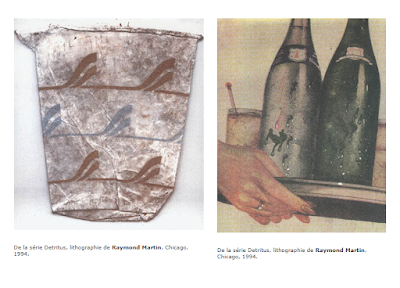Ray Martin Recent Prints, Chicago Cultural Center, 1997 (New Art Examiner, Chicago)
Marcelo Guimarães Lima
Note: This review of Ray Martin´s exhibition was written for the New Art Examiner in 1997. I do not remember if it was in fact published due to deadline and other issues common to magazine life, editorship and what not. In any case, I publish it here as a document of the writer in Chicago in the late part of the 20th century.
UPDATE: Review was published: New Art Examiner, April 1997, pages 45-46.
I thank editor Michel Ségard for the information.
If the motivation to dedicate himself to the making of books came to printmaker and graphic designer Ray Martin by the influence of the works of the Fluxus artists, it is clear that in his approach the book becomes a more exacting, stringent and absorbing form.
So absorbing in fact that exhibited in the walls of the gallery at the Chicago Art Center these works lose something of their original impact, or to put it in another way, they remind us constantly of the other space they were made for, the space of the book, and of the other relationships to those images that the book itself implies: to handle the pages, to discover the flow of layered images between the dark covers of the bound volumes, to manipulate images that in Martin´s case appear to us in the familiarity and strangeness of a visual ecriture that at times resonates as a foreign dialect, at other times as a once known and presently forgotten language.
And in fact, what may be seen simply as an all to common dilemma of the presentation of artist books in general in the walls of a gallery, can also be thought here as a compound effect or duplication of the ambiguities and tensions already present in the very medium, in the chosen medium of Ray Martin´s works that the artist explores in a systematic and meticulous way.
Indeed, Martin´s exploration of lithography and offset lithography, and of the book format stresses a more or less subtle dialectic of proximity and distance that we can relate to Walter Benjamin´s notions of the dialectics of the mechanized work of art. For Benjamin, graphic reproduction and multiplication allowed the liberation of artistic production from the ideological servitude of tradition and of the “cult of art” by a continuous process of de-contextualization and re-contextualization of images doing away with the “auratic” power of tradition.
Playing on its own traditions, Martin´s works reach beyond the initial influence of Fluxus towards the artists of Dada (one of the historical sources of Fluxus and of the avant-garde of the sixties and seventies). Something of the graphic sensibility of a Schwitters or a Höch and of the graphic energies of a Hartfield print-works can be seen in series such as the Master Painter suite of prints (1992) and the series Detritus (1996). Detritus presents art made of garbage, or rather, of the manipulated images of garbage such as crushed soda cans. Martin´s soda cans and bottles lithographs may also be read as a kind of post-pop(ulist) commentary on pop-art.
In contrast to the photographic based images of the majority of the works presented, in the series Achilles the variations on feet, hands, shoes and boots are hand drawn as pages of a sketchbook or drawing book. In it, the spontaneous quality of the sketch is transformed by the mechanization of the offset process: the exacting, clean and precise technique of the artist-printmaker changes “hot” hand made marks into “cold” printed signs.
The subjective, expressive dimension of the creative process is here seen as moments of the technical process of reproduction. And this play of autography and allography, that is, the marks (signs) of the self and of the other, illuminates the central tension (in general terms) at work in the show: the dejects and fragments of present day material culture incorporated into art may have the power to transgress the boundaries of the “artistic domain”, but they also run the risk of reinforcing and restating a new version of the ideological notion of art they were supposed to challenge in the first place.
It is said that the artists of Fluxus wanted to erase the distinctions, fill the gap and resolve the contradictions between art and life. Ray Martin, rather “perversely” I believe (but this is open to interpretation) recreates out of those contradictions an aesthetics.



Comments
Post a Comment